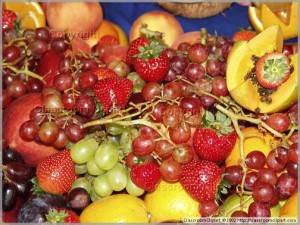A recent study from the Center for Disease Control showed that only about 1 in 10
Americans eat the recommended amounts of fruits and vegetables each day–1 1/2 to 2 cups fruits and 2-3 cups vegetables. We are far worse at eating vegetables than fruits. About 13% of us eat enough fruit, while only about 9% eat enough vegetables. Residents of California and Oregon do better than other areas of the country, but that doesn’t say a lot–only 13% of us Oregonians eat the recommended amounts of vegetables.
How can you fit those fruits and veggies into your day?
Breakfast:
Add a 1/2 medium to large apple, orange, banana, peach, nectarine, or a cup of grapes, berries or melon, OR cooked those eggs with a cup of raw spinach or have a sliced tomato  on the side, or make a veggie omelet or fritatta.
on the side, or make a veggie omelet or fritatta.
Lunch:
Add a couple leaves of romaine or other leafy green lettuce and a couple slices of tomato to  your sandwich, and have a green salad, coleslaw, or raw veggies on the side.
your sandwich, and have a green salad, coleslaw, or raw veggies on the side.
Snacks:
Fresh fruit or veggies; or a mixture of dried fruit, nuts and whole grain dry cereal (e.g. Cheerios™, Spoon Size Shredded Wheat™)
Dinner:
Roast potatoes with bell peppers, onion, mushrooms, cauliflower, zucchini–be creative, or add sauteed chopped vegetables to rice or pasta, AND have another steamed vegetable and/or green salad. Have fresh fruit by itself, on top of your ice cream, or with your cookie or cake for dessert.
Make sure that some form of fruit or veggie is a part of every meal and snack you eat!
Make eating fruits and veggies easy and convenient!
- Keep frozen veggies and fruit in your freezer for quick and easy addition to meals.
- Wash and cut up raw veggies and store in a clear plastic container in the front of your fridge, for quick snacks and additions to meals
- Buy pre-washed spinach or greens for quick salads
- Keep easily transported fruits for meals away from home (apples, oranges, grapes, plums travel a bit better than bananas, peaches, pears or berries) Put more fragile fruit in plastic containers to keep it from being bruised in transit.
Quick recipes:
Chicken veggie stir-fry:
Ingredients:
Oil (olive, peanut, grape seed, canola or other liquid oil)
Raw chicken tenders, or boneless, skinless chicken breast or thighs–cut in stips (1/4 lb/person)Bag of frozen stir fry veggies (use 1-2 cups frozen veggies/person).
Low sodium chicken broth (1/2 cup/person)
Teriyaki Sauce (2-3 tbsp/person)
Corn Starch (1 tbsp/cup of liquid, broth and teriyaki sauce combined)
Spices: garlic powder, onion powder, ground ginger
Quick cooking brown rice or quinoa
Directions: Start water boiling for rice or quinoa, and cook according to package instructions for number of people to be served. Heat heavy frying pan, add chicken and spices, saute until starting to brown. Add veggies, saute until thawed. Mix chicken broth and teriyaki sauce together with corn starch; stir to dissolve corn starch, then pour into frying pan with other ingredients. Toss/stir until sauce is boiling; add extra chicken broth if thinner consistency is desired. Serve over rice or quinoa.
Creamy Salad Dressing or dip:
Ingredients:
1/2 cup plain Greek Yogurt2 Tbsp Mayonnaise (regular or “light”)
Spices to taste: garlic powder, onion powder, paprika, dry mustard and dill weed
Directions
Mix together and enjoy as dip for raw veggies. If a thinner dressing is desired, for pouring over green salad, add a little milk, or use regular plain yogurt instead of Greek yogurt.
Note: mixture contains 29 calories/tbsp if made with lowfat Greek yogurt and real mayonnaise; 14 calories/tbsp if made with non-fat Greek yogurt and Light mayonnaise.
